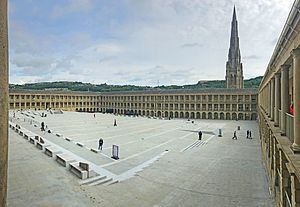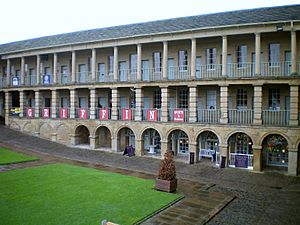Piece Hall facts for kids
Quick facts for kids Piece Hall |
|
|---|---|

Piece Hall
|
|
| Location | Halifax |
| Built | 1779 |
|
Listed Building – Grade I
|
|
| Designated | 3 November 1954 |
| Reference no. | 1273056 |
| Lua error in Module:Location_map at line 420: attempt to index field 'wikibase' (a nil value). | |
The Piece Hall is a very special historic building in Halifax, West Yorkshire, England. It's a 'Grade I listed building', which means it's super important and protected. Long ago, it was built as a huge market called a 'cloth hall'. Here, people who made woollen cloth by hand, called 'handloom weavers', would come to sell their finished pieces of fabric.
Contents
History of the Piece Hall
Building a Special Market
The idea for the Piece Hall first appeared in a leaflet from 1774. People wanted a special place to sell woollen and worsted goods. These were fabrics made in Halifax and nearby towns. The goal was to bring buyers and sellers together. This would create a fair market and stop people from cheating.
Two places were suggested for the new building. The area called Talbot Croft was chosen. It was bought in September 1774. The Piece Hall officially opened its doors on January 1, 1779. It had 315 separate rooms. These rooms were built around a large open courtyard.
Who Designed It?
No one knows for sure who designed the Piece Hall. There aren't many old papers that explain its plans. Some people think Thomas Bradley was the architect. Others have suggested Samuel and John Hope or John Carr.
In 1831, someone described the Piece Hall. They said it was a huge stone building. It covered an area of ten thousand square yards. It had two upper floors with walkways. These walkways led to arched rooms. Here, goods were stored and shown to merchants. Sales happened every Saturday morning. The building cost about £12,000 to build. It was seen as elegant, useful, and safe. It was also protected against fire.
Changes Over Time
The Industrial Revolution brought big changes. Factories started making cloth instead of small weavers. These new, larger mills sold directly to merchants. The Piece Hall became less important. In 1868, the local council bought it. They turned it into a wholesale market. Some small rooms were joined to make bigger shops. New cellars were added. The main gate was made larger for vehicles. Iron gates were put in place. Sheds and toilets were also built in the courtyard.
Becoming a Tourist Spot
By 1971, the Piece Hall was not good for a market anymore. Some people even thought about tearing it down. But the government offered money to save it. The Halifax Council got funds to make it a tourist attraction. The sheds built in the 1800s were removed. The courtyard was made beautiful again. Walls were taken down inside to create new shops. A new museum and art gallery opened in 1976. The Piece Hall reopened to visitors on July 3, 1976. The museum and art gallery closed in 1998.
In 2010, the Heritage Lottery Fund gave money for more repairs. A big restoration project started in 2014. It cost £19 million. The Piece Hall reopened again on August 1, 2017. It even hosted its first big music event with Father John Misty. Today, a charity called Piece Hall Trust manages the building.
What Does 'Listed' Mean?
The Piece Hall was made a 'listed building' on November 3, 1954. It has 'Grade I listed protection'. This means it is one of the most important historic buildings in England. It is protected by law.
It was listed for several reasons:
- Historic Importance: It shows how rich Halifax was when it was built. It also shows the scale and beauty of its design.
- Rarity: Not many cloth halls built for this purpose still exist today.
- Architectural Design: Its design is very impressive. The detailed walkways and courtyard are special. The building shows high-quality work and materials.
- Layout: The courtyard design with individual rooms was clever. It allowed people to do business privately. Even though some rooms were changed inside, the outside still looks the same.


